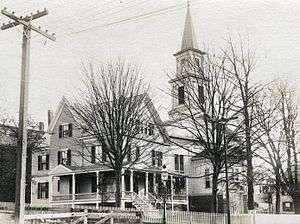United Baptist Church (Newport, Rhode Island)

The United Baptist Church, John Clarke Memorial (previously known as the First Baptist Church in Newport, Second Baptist Church in Newport and the Second Baptist Church in America) is a historic Baptist church in Newport, Rhode Island, USA that was founded in 1638-1644. It is one of the two oldest Baptist congregations in the United States and is currently affiliated with the American Baptist Church. The current meeting house of the church was constructed in 1846.
History

17th century
Around 1638 Roger Williams founded the First Baptist Church in America in nearby Providence, after being exiled from Massachusetts in 1636. In 1638 John Clarke, a minister, from Great Britain, started leading worship in nearby Portsmouth, Rhode Island (Newport County) after he and his congregation were exiled from Massachusetts after disagreements with the Puritan leadership.
By 1644 Clarke's group moved to Newport where the current church was founded and the first meeting house was constructed at Green's End within that same year, which was the first church building of any denomination in the colony. The congregation used the building until 1708 when the first meeting house in Newport was constructed on Tanner Street in Newport on the corner of Calendar Avenue, adjacent to the cemetery, which was established on land donated by Clarke. In addition to Clarke, Obadiah Holmes and John Crandall were active in the leadership of the church in the seventeenth century.
In 1656, while Clarke was in England — advocating for the Colony's royal charter and religious liberty — a group of congregants broke off from the church to found the Second Baptist Church in Newport, which followed Six Principle Baptist (Arminian) principles in contrast to Clarke's more Calvinist theology. (Second Baptist would eventually reunite with First Baptist in 1946, hence its present name.)
In December 1671,[1] two members of the church — Samuel and Tacy Hubbard[2] — withdrew and joined with Stephen Mumford, a Seventh Day Baptist (SDB) from England, and others. Their new congregation was the first SDB church in America.
18th century
From 1731 to 1748 John Callendar, a prominent clergyman and author, served as pastor of the church. In 1737 Hezekiah Carpenter and Josiah Lyons donated the current land on Spring Street for a meeting house which was constructed that year.
19th century
The current meeting house was constructed as a replacement in 1846, and the earlier building was eventually moved, then demolished.
20th century
According to the United Baptist Church's website "[i]n 1943, the Rev. Lester Revoir, who became the pastor of the nearby Second Baptist Church on Clarke Street, in 1942, added to his responsibilities by becoming the pastor of the First Baptist Church. Three years later, in 1946, the First and Second Baptist Churches merged to form “The United Baptist Church, John Clarke Memorial", the present name of the church."[3] The church steeple was replaced with a smaller version after the 1938 Hurricane.[4]
21st century
The church's current meeting house is located at 30 Spring Street in Newport, Rhode Island and services are held weekly at 10 a.m. with Bible studies held during the week.[5]
See also
References
- ↑ Sanford, Don A (1991), Conscience Taken Captive: A Short History of Seventh Baptists, Seventh Day Baptist Historical Society, pg 91.
- ↑ Andrews, J.N. (1873). History of the Sabbath and first day of the week (Making of America online ed.). Battle Creek, MI: Seventh-day Adventist Publishing Association. p. 494.
- ↑ "United Baptist Web Site". United Baptist Web Site. Retrieved 29 November 2014.
- ↑ History of the First Baptist church in Newport, R. I.; a discourse delivered on Thanksgiving day, November 30, 1876 (1876) https://archive.org/details/historyoffirstba00barr
- ↑ "United Baptist Web Site". United Baptist Web Site. Retrieved 29 November 2014.